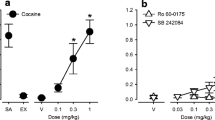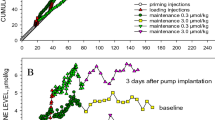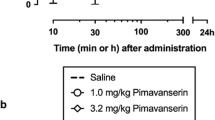Abstract
Modification of the behavioral effects of cocaine by the selective serotonin (5-HT) uptake inhibitors citalopram and fluoxetine and the selective dopamine (DA) uptake inhibitor GBR 12909 was investigated in squirrel monkeys trained under a fixed-interval schedule of reinforcement or a two-lever cocaine-discrimination procedure. Under the fixed-interval schedule cocaine (0.03–1.78 mg/kg) produced dose-related increases in response rate, reaching an average maximum of 215% of control after a dose of 0.3 mg/kg. Similar rate-increasing effects were seen with GBR 12909 (3.0 or 10.0 mg/kg), but not citalopram (10.0 or 17.8 mg/kg) or fluoxetine (10.0 mg/kg). Pretreatment with citalopram or fluoxetine attenuated the rate-increasing effects of cocaine and produced an overall downward shift in the cocaine dose-response function. Pretreatment with GBR 12909, on the other hand, produced an overall leftward shift in the cocaine dose-response function. Under the drug-discrimination procedure cocaine (0.03–1.78 mg/kg) engendered dose-related increases in the percentage of cocaine-appropriate responses, as did GBR 12909 (1.0–17.8 mg/kg) but not citalopram (1.0–17.8 mg/kg). Pretreatment with citalopram attenuated the discriminative stimulus effects of cocaine and produced an overall rightward shift in the cocaine dose-response function, whereas pretreatment with GBR 12909 produced an overall leftward shift in the cocaine dose-response function. The results show that selective 5-HT and DA uptake inhibitors can modify the rate-altering and discriminative stimulus effects of cocaine in qualitatively different ways and suggest a modulatory role for 5-HT uptake inhibition in the behavioral effects of cocaine.
Similar content being viewed by others
References
Andersen PH (1989) The dopamine uptake inhibitor GBR 12909: selectivity and molecular mechanism of action. Eur J Pharmacol 166:493–504
Baldessarini RJ, March E (1990) Fluoxetine and side effects. Arch Gen Psychiatry 47:191–192
Berger P, Gawin F, Kosten TR (1989) Treatment of cocaine abuse with mazindol. Lancet I:283
Bergman J, Madras BK, Johnson SE, Spealman RD (1989) Effects of cocaine and related drugs in nonhuman primates. III. Self-administration by squirrel monkeys. J Pharmacol Exp Ther 251:150–155
Bergman J, Kamien JB, Spealman RD (1990) Antagonism of cocaine self-administration by selective D1 and D2 antagonists. Behav Pharmacol 1:355–363
Broadbent J, Michael EK, Riddle EE, Appel JB (1991) Involvement of dopamine uptake in the discriminative stimulus effects of cocaine. Behav Pharmacol 2:187–197
Carroll ME, Lac ST, Asencio M, Kragh R (1990a) Fluoxetine reduces intravenous cocaine self-administration in rats. Pharmacol Biochem Behav 35:237–244
Carroll ME, Lac ST, Asencio M, Kragh R (1990b) Intravenous cocaine self-administration in rats is reduced by dietary 1-tryptophan. Psychopharmacology 100:293–300
Cunningham KA, Callahan PM (1991) Monoamine reuptake inhibitors enhance the discriminative state induced by cocaine in the rat. Psychopharmacology 104:177–180
DeSimoni MG, Dal Toso G, Fodritto F, Sokola A, Algeri S (1987) Modulation of striatal dopamine metabolism by the activity of dorsal raphe serotonergic afferents. Brain Res 411:81–88
Ennis C, Kemp JD, Cox B (1981) Characterization of inhibitory 5-hydroxytryptamine receptors that modulate dopamine release in the striatum. J Neurochem 36:1515–1520
Fahey MA, Canfield DR, Spealman RD, Madras BK (1989) Comparison of [3H]GBR 12935 and [3H]cocaine binding sites in monkey brain. Soc Neurosci Abstr 15:1090
Gauvin DV, Young AM (1989) Evidence for perceptual masking of the discriminative morphine stimulus. Psychopharmacology 98:212–221
Howell LL, Byrd LD (1991) Characterization of the effects of cocaine and GBR 12909, a dopamine uptake inhibitor, on behavior of the squirrel monkey. J Pharmacol Exp Ther 258:178–185
Hurd YL, Kehr J, Ungerstedt U (1988) In vivo microdialysis as a technique to monitor drug transport: correlation of extracellular cocaine levels and dopamine overflow in the rat brain. J Neurochem 51:1314–1316
Hyttel J (1982) Citalopram — pharmacological profile of a specific serotonin uptake inhibitor with antidepressant activity. Prog Neuropsychopharmacol Biol Psychiatry 6:277–295
James TA, Starr MS (1980) Rotational behavior elicited by 5-HT in the rat: evidence for an inhibitory role of 5-HT in the substantia nigra and corpus striatum. J Pharm Pharmacol 32:196–200
Kelland MD, Freeman AS, Chiodo LA (1990) Serotonergic afferent regulation of the basic physiology and pharmacological responsiveness of nigrostriatal dopamine neurons. J Pharmacol Exp Ther 253:803–811
Kelley AE, Lang CG (1989) Effects of GBR 12909, a selective dopamine uptake inhibitor, on motor activity and operant behavior in the rat. Eur J Pharmacol 167:385–395
Kennedy LT, Hanbauer I (1983) Sodium-sensitive cocaine binding to rat striatal membranes: possible relationship to dopamine uptake sites. J Neurochem 41:172–178
Kleven MS, Anthony EW, Woolverton WL (1990) Pharmacological characterization of the discriminative stimulus effects of cocaine in rhesus monkeys. J Pharmacol Exp Ther 254:312–317
Korsgaard S, Gerlach J, Christensson E (1985) Behavioral aspects of serotonin-dopamine interaction in the monkey. Eur J Pharmacol 118:245–252
Madras BK, Fahey MA, Bergman J, Canfield DR, Spealman RD (1989a) Effects of cocaine and related drugs in nonhuman primates. I. [3H]Cocaine binding sites in caudate-putamen. J Pharmacol Exp Ther 25:131–141
Madras BK, Spealman RD, Fahey MA, Neumeyer JL, Saha JK, Milius RA (1989b) Cocaine receptors labeled by [3H]2β-carbomethoxy-3β-(4-fluorophenyl)tropane. Mol Pharmacol 30:518–524
Margolin A, Kosten T, Petrakis I, Avants SK, Kosten T (1991) Bupropion reduces cocaine abuse in methadone-maintained patients. Arch Gen Psychiatry 48:87
McKenna ML, Ho BT (1980) The role of dopamine in the discriminative stimulus properties of cocaine. Neuropharmacology 19:297–303
Melia KF, Kamien JB, Spealman RD (1989) Interoceptive effects of some monamine transport inhibitors in squirrel monkeys trained to discriminate cocaine or GBR 12909 from saline. FASEB J 3:A296
Morse WH, Kelleher RT (1966) Schedules using noxious stimuli. I. Multiple fixed-ratio and fixed-interval termination of schedule complexes. J Exp Anal Behav 9:267–290
Nissbrandt H, Waters N, Hjorth S (1992) The influence of serotoninergic drugs on dopaminergic neurotransmission in the rat substantia nigra, striatum and limbic forebrain in vivo. Naunyn-Schmiedeberg's Arch Pharmacol 346:12–19.
Perry KW, Fuller RW (1992) Effect of fluoxetine on serotonin and dopamine concentration in microdialysis fluid from rat striatum. Life Sci 50:1683–1690
Pettit HO, Justice JB Jr (1989) Dopamine in the nucleus accumbens during cocaine self-administration as studied by in vivo microdialysis. Pharmacol Biochem Behav 34:899–904
Porrino LJ, Ritz MC, Goodman NL, Sharpe LG, Kuhar MJ, Goldberg SR (1989) Differential effects of the pharmacological manipulation of serotonin systems on cocaine and amphetamine self-administration in rats. Life Sci 45:1529–1535
Reith MEA, Selmeci G (1992) Radiolabeling of dopamine uptake sites in mouse striatum: comparison of binding sites for cocaine, mazindol and GBR 12935. Naunyn-Schmiedeberg's Arch Pharmacol 345:309–318
Reith MEA, Sershen H, Allen DL, Lajtha A (1983) A portion of [3H]cocaine binding in brain is associated with serotonin neurons. Mol Pharmacol 23:600–606
Reith MEA, Meisler BE, Sershen H, Lajtha A (1986) Structural requirements for cocaine congeners to interact with dopamine and serotonin uptake sites and to induce stereotyped behavior. Biochem Pharmacol 35:1123–1129
Richardson NR, Roberts DCS (1991) Fluoxetine pretreatment reduces breaking points on a progressive ratio schedule reinforced by intravenous cocaine self-administration in the rat. Life Sci 49:833–840
Ritz MC, Lamb RJ, Goldberg SR, Kuhar MJ (1987) Cocaine receptors on dopamine transporters are related to self-administration of cocaine. Science 237:1219–1223
Rothman RB (1990) High affinity dopamine reuptake inhibitors as potential cocaine antagonists: a strategy for drug development. Life Sci 46:PL-17–PL-21
Spealman RD (1992) Failure of cholecystokinin antagonists to modify the discriminative stimulus effects of cocaine. Pharmacol Biochem Behav 43:613–616
Spealman RD, Madras BK, Bergman J (1989) Effects of cocaine and related drugs in nonhuman primates. II. Stimulant effects on schedule-controlled behavior. J Pharmacol Exp Ther 251:142–149
Spealman RD, Bergman J, Madras BK, Melia KF (1991) Discriminative stimulus effects of cocaine in squirrel monkeys: involvement of dopamine receptor subtypes. J Pharmacol Exp Ther 258:945–953
van der Zee P, Koger HS, Gootjes J, Hespe W (1980) Aryl 1,4-dialk(en)yl-piperazines as selective and very potent inhibitors of dopamine uptake. Eur J Med Chem 15:363–370
Waldmeier PC, Delini-Stula AA (1979) Serotonin-dopamine interactions in the nigrostriatal system. Eur J Pharmacol 55:363–373
Witkin JM, Nichols DE, Terry P, Katz JL (1991) Behavioral effects of selective dopaminergic compounds in rats discriminating cocaine injections. J Pharmacol Exp Ther 257:706–713
Wong DT, Bymaster FP, Horng JS, Hauser KL, Molloy BB (1974) A selective inhibitor of serotonin uptake: Lilly 110140, 3-(p-trifluoromethylphenoxy)-N-methyl-3-phenylpropylamine. Life Sci 15:471–479
Wong DT, Threlkeld PG, Robertson DW (1991) Affinities of fluoxetine, its enantiomers, and other inhibitors of serotonin uptake for subtypes of serotonin receptors. Neuropsychopharmacology 5:43–47
Zwislocki JJ (1978) Masking: experimental and theoretical aspects of simultaneous, forward, and central masking. In: Carterette EC, Friedman MP (eds) Handbook of perception, IV. Academic Press, New York, pp 283–334
Author information
Authors and Affiliations
Rights and permissions
About this article
Cite this article
Spealman, R.D. Modification of behavioral effects of cocaine by selective serotonin and dopamine uptake inhibitors in squirrel monkeys. Psychopharmacology 112, 93–99 (1993). https://doi.org/10.1007/BF02247368
Received:
Revised:
Issue Date:
DOI: https://doi.org/10.1007/BF02247368




